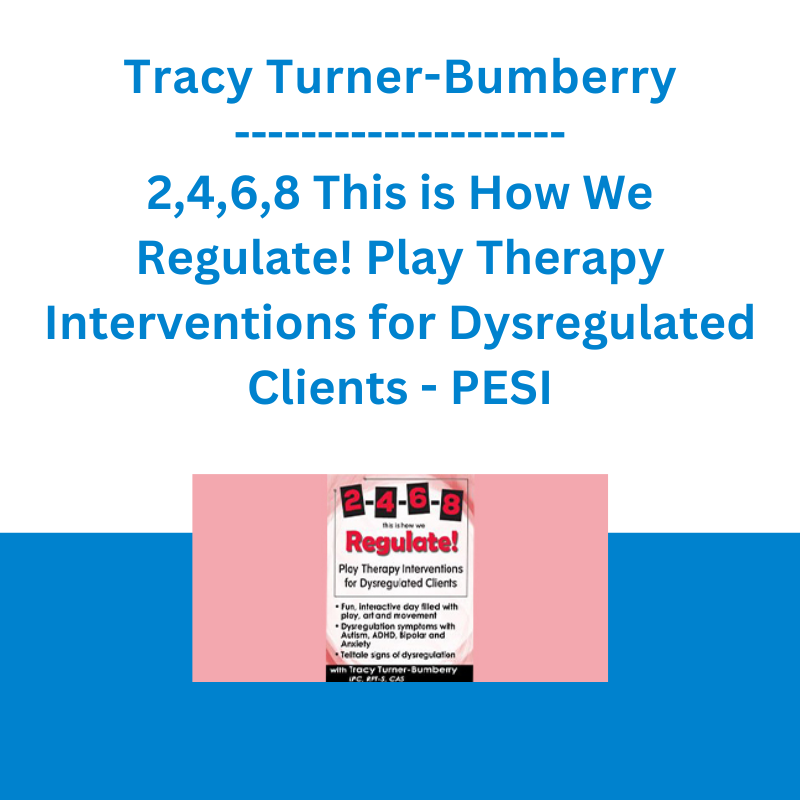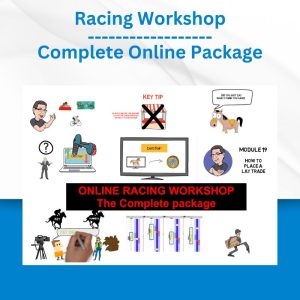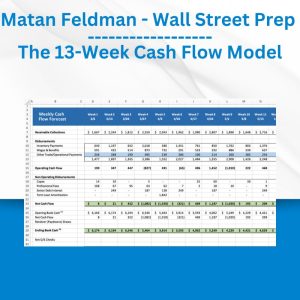*** Proof of Product ***
Exploring the Essential Features of “Tracy Turner-Bumberry – 2,4,6,8 This is How We Regulate! Play Therapy Interventions for Dysregulated Clients – PESI”
Speaker: Tracy Turner-Bumberry, LPC, RPT-S, CAS
Format: Audio and Video
Media Type: Digital Seminar
Description
Are your clients having anger outbursts, meltdowns, crying spells or long, intense moments of hyperactive joy? This is dysregulation, and it doesn’t feel good!
Join Tracy Turner-Bumberry, LPC, RPT-S, in this recording as she teaches you art, movement and play therapy interventions to help regulate clients with Autism, ADHD, Bipolar and Anxiety. You will practice techniques during this recording to experience for yourself how to achieve calm, cool, and relaxed children and adolescents. Leave this recording armed with a tool kit of Play Therapy interventions to reduce meltdowns, mood swings, anger outbursts and create sustained emotion regulation.
You will learn how play is a therapeutic and natural way for children who have limited verbal skills to express their needs and frustrations.
Play allows children to:
- Experience and express emotion
- Become more responsible for behaviors and develop more successful strategies
- Develop new and creative solutions to problems
- Reduce fear, anxiety and depression
As the great philosopher Plato says, “You can discover more about a person in an hour of play than in a year of conversation.”
Speaker
Tracy Turner-Bumberry, LPC, RPT-S, CAS
Seva Counseling LLC
Objectives
- Assess and describe key dysregulation issues in clients that affect their physical and emotional well-being.
- Distinguish symptoms of dysregulation in Autism, ADHD, bipolar and anxiety disorders.
- Assess “intentional practice” and explain its role towards creating sustained regulation in clients.
- Practice “instant regulator” interventions to help create an immediate calm therapy environment.
- Employ play therapy interventions that can easily be replicated to reduce client meltdowns and mood swings at home and school.
- Utilize 3 strategies to reduce anger outbursts to sustain emotion regulation.
Outline
How Dysregulation Manifests in Children and Adolescents
- Levels of dysregulation
- Mood swings vs dysregulation
- Intentional behavior vs dysregulation Special considerations
- Actively engage your brain structures for change
- Treatment plan goals w/focus on intentional practice
ICD-10 Diagnoses with Higher Levels of Dysregulation (case examples)
- Autism Spectrum Disorder
- ADHD
- Anxiety disorders
- Bipolar disorder
Instant Regulator Activities for Client Focused Sessions
- Finger breathing
- Gong breath
- Sensory ABC’s
- Jump in the Picture
- Move to review
Art Interventions: Drawing, Coloring, Creating
- Activate the whole brain for emotional, cognitive and sensory regulation
- Uplift mood
- Reduce anxiety, fear and depression
- Improve focus and mindfulness
- Creates healing through non-verbal expression
Play Therapy Interventions: Superhero, Improv, Role Play and Games
- Relax and stabilize ADHD and bipolar
- Release any excess energy
- Provide a safe and sacred space for emotional expression
- Increase confidence and motivation
- Encourage creative thought, new ideas, and a sense of joy
Movement Interventions: Fine and Gross Motor
- Experience competence to communicate and express emotion
- Inspires self-confidence to tackle complex challenges
- Move w/therapist to create trust and build rapport
- Facilitates in getting the intense emotion out of the body
Target Audience
- Play Therapists and Play Therapists in training
- Child Psychologists
- Social Workers
- School Counselors
- Therapists in inpatient hospital settings
- Educators
- Occupational Therapists and Occupational Therapy Assistants
- Certified Autism Specialists
Please see the full list of alternative group-buy courses available here: https://lunacourse.com/shop/










 Matan Feldman - The 13-Week Cash Flow Modeling - Wall Street Prep
Matan Feldman - The 13-Week Cash Flow Modeling - Wall Street Prep  Alphashark - The AlphaShark SV-Scalper
Alphashark - The AlphaShark SV-Scalper  Akil Stokes & Jason Graystone - TierOneTrading - Trading Edge 2019
Akil Stokes & Jason Graystone - TierOneTrading - Trading Edge 2019  Matthew Kratter - Trader University
Matthew Kratter - Trader University